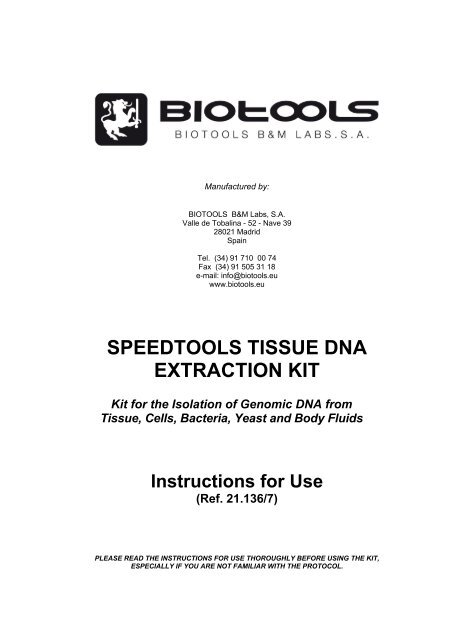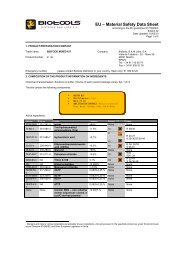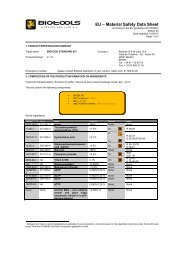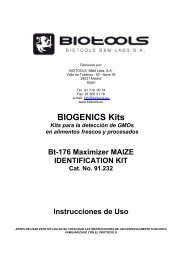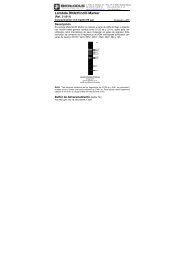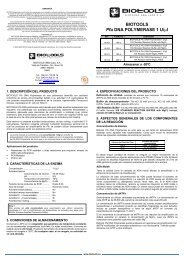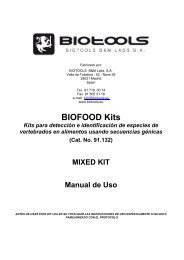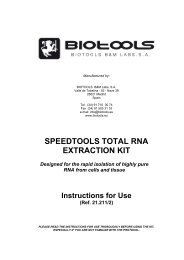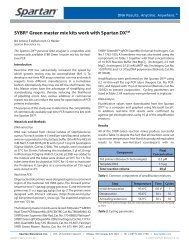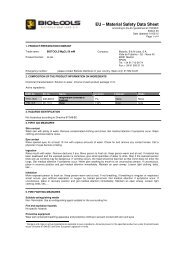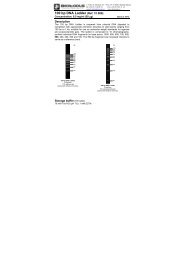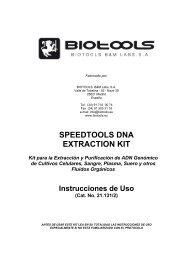SPEEDTOOLS TISSUE DNA EXTRACTION KIT - Biotools
SPEEDTOOLS TISSUE DNA EXTRACTION KIT - Biotools
SPEEDTOOLS TISSUE DNA EXTRACTION KIT - Biotools
- No tags were found...
You also want an ePaper? Increase the reach of your titles
YUMPU automatically turns print PDFs into web optimized ePapers that Google loves.
Manufactured by:BIOTOOLS B&M Labs, S.A.Valle de Tobalina - 52 - Nave 3928021 MadridSpainTel. (34) 91 710 00 74Fax (34) 91 505 31 18e-mail: info@biotools.euwww.biotools.eu<strong>SPEEDTOOLS</strong> <strong>TISSUE</strong> <strong>DNA</strong><strong>EXTRACTION</strong> <strong>KIT</strong>Kit for the Isolation of Genomic <strong>DNA</strong> fromTissue, Cells, Bacteria, Yeast and Body FluidsInstructions for Use(Ref. 21.136/7)PLEASE READ THE INSTRUCTIONS FOR USE THOROUGHLY BEFORE USING THE <strong>KIT</strong>,ESPECIALLY IF YOU ARE NOT FAMILIAR WITH THE PROTOCOL.
Table of Contents1. BASIC PRINCIPLE ............................................................................................ 22. <strong>KIT</strong> CONTENTS ................................................................................................. 23. INTENDED USE ................................................................................................. 24. PREPARATION OF WORKING SOLUTIONS AND STORAGECONDITIONS ..................................................................................................... 35. <strong>DNA</strong> ELUTION PROCEDURES ........................................................................ 36. SAFETY INSTRUCTIONS ................................................................................. 47. INSTRUCTION FOR USE .................................................................................. 5A. STANDARD PROTOCOL (for human or animal tissue and cultured cells) ........ 5B. Protocol for mouse or rat tails .............................................................................................. 6C. Protocol for bacteria .................................................................................................................. 7D. Protocol for purification of bacterial <strong>DNA</strong> (e.g. Chamydia trachomatis) fromcultures, biological fluids or clinical specimens ........................................................... 7E. Protocol for yeast ....................................................................................................................... 8F. Protocol for dried blood spots .............................................................................................. 9G. Protocol for hair roots .............................................................................................................. 9H. Protocol from paraffin-embedded tissue ....................................................................... 10I. Protocol for detection of Mycobacterium tuberculosis or Legionellapneumophila in sputum or bronchoalveolar lavage ................................................... 10J. Protocol for extraction of genomic <strong>DNA</strong> from stool .................................................. 11K. Protocol for detection of EHEC bacteria in food (e.g. fresh cows’ milk) .......... 11L. Protocol for purification of bacterial <strong>DNA</strong> (e.g. Borrelia burgdorferi) fromurine ................................................................................................................................................. 12M. Protocol for purification of viral <strong>DNA</strong> (e.g. CMV) from urine................................. 12N. Protocol for purification of genomic <strong>DNA</strong> from insects .......................................... 14O. Protocol for purification of genomic <strong>DNA</strong> from dental swabs .............................. 14P. Protocol for purification of genomic <strong>DNA</strong> from buccal swabs ............................. 158. TROUBLESHOOTING ..................................................................................... 169. ORDERING INFORMATION ............................................................................ 1810.PRODUCT USE RESTRICTION AND WARRANTY ...................................... 18Ed 05 – March 12Page 1 of 19<strong>SPEEDTOOLS</strong> <strong>TISSUE</strong> <strong>DNA</strong> <strong>EXTRACTION</strong> <strong>KIT</strong>
1. BASIC PRINCIPLE<strong>SPEEDTOOLS</strong> <strong>TISSUE</strong> <strong>DNA</strong> <strong>EXTRACTION</strong> <strong>KIT</strong> is designed for the rapid isolation of highly pure genomic<strong>DNA</strong> from: tissue, cells (e.g. bacteria, yeast), paraffin embedded samples, urine, feces, dried bloodspots and many other sources.Lysis is achieved by incubation of the sample material in a proteinase K / SDS solution. Afterwards thelysate is treated with chaotropic ions and ethanol to create the appropriate conditions for binding of <strong>DNA</strong> tothe silica membrane of the column. The binding process is reversible and specific to nucleic acids. Thewashing steps efficiently remove contaminations and pure genomic <strong>DNA</strong> is finally eluted under low ionicstrength conditions in a slightly alkaline elution buffer.2. <strong>KIT</strong> CONTENTS<strong>SPEEDTOOLS</strong> <strong>TISSUE</strong> <strong>DNA</strong> <strong>EXTRACTION</strong> <strong>KIT</strong>REAGENTS50 PrepsRef. 21.136250 PrepsRef. 21.137Buffer BT1 20 ml 5 x 20 mlBuffer BB1 10 ml 5 x 10 mlReagent BB2 2.5 ml 5 x 2.5 mlBuffer BB5 (concentrate) 7 ml 5 x 7 mlBuffer BBW 30 ml 5 x 30 mlBuffer BBE 13 ml 5 x 13 mlProteinase K (lyophilized) 30 mg 5 x 30 mgProteinase Buffer 1.8 ml 5 x 1.8 mlSpeedtools Tissue Columns(plus Collecting Tubes)50 5 x 502 ml Collecting Tubes 100 5 x 100Label for Buffer BB3 1 5 x 1Protocol 1 5 x 13. INTENDED USEWith the <strong>SPEEDTOOLS</strong> <strong>TISSUE</strong> <strong>DNA</strong> method, total <strong>DNA</strong> (genomic and mitochondrial) is prepared fromtissue, cells and many other sources. It is also suitable for purify bacterial and viral <strong>DNA</strong> from thesesamples.One Speedtools Tissue Column is capable of binding up to 60 µg of genomic <strong>DNA</strong>. It allows isolation of upto 35 µg of highly pure genomic <strong>DNA</strong> with an A260/280-ratio between 1.60 and 1.90.For lysis of certain bacterial and yeast strains additional enzymes not included in the kit may be necessary.Relevant support protocols are provided with this manual.The obtained <strong>DNA</strong> is ready to use for subsequent reactions like PCR, Southern blotting, or any kind ofenzymatic reactions.Ed 05 – March 12Page 2 of 19<strong>SPEEDTOOLS</strong> <strong>TISSUE</strong> <strong>DNA</strong> <strong>EXTRACTION</strong> <strong>KIT</strong>
Table 1: General Characteristics of the KitSampleSAMPLE SIZE25 mg / 10 7 cellsAVERAGE YIELD 35 µgELUTION VOLUME 100 µlBINDING CAPACITY 60 µgTIME / PREPSPIN COLUMN TYPE20 min / 4-6 preps(after lysis of sample)mini4. PREPARATION OF WORKING SOLUTIONS AND STORAGE CONDITIONSNOTEBuffers BB1, BB3 and BBW contain guanidine hydrochloride therefore wear gloves and goggles.All kit components can be stored at room temperature (18-25°C) through the expiration date printed on thepackaging label.Before starting any protocol with <strong>SPEEDTOOLS</strong> <strong>TISSUE</strong> <strong>DNA</strong> <strong>EXTRACTION</strong> <strong>KIT</strong> prepare the followingreagents:• Proteinase K: Add 1.35 ml of Proteinase Buffer to dissolve lyophilized Proteinase K. ProteinaseK Solution is stable at –20°C for up to 6 months.• Buffer BB3: Transfer Buffer BB1 to Reagent BB2 completely and mix well. The resulting solution(a label is provided) Buffer BB3 is stable for up to 12 months at room temperature (18-25°C).• Buffer BB5: Add 28 ml of ethanol (96-100%) to buffer BB5 concentrate. Store Buffer BB5 at roomtemperature (18-25°C) for up to 12 months.Upon storage, especially at low temperatures, a white precipitate may form in Buffers BT1, BB1 orBuffer BB3. Dissolve such precipitates by incubation of the bottle at 50-70°C before use.5. <strong>DNA</strong> ELUTION PROCEDURESThe Standard Protocol described in Section 6 has a recovery rate about 70-90%. It is possible to adapt theelution method and volume of elution buffer to the subsequent application of interest. In addition to theStandard Protocol there are several modifications possible. Use elution Buffer BBE preheated to 70°C forone of the following procedures:A) High yield: Perform two elution steps with the volume indicated in the individual protocol. About90-100% of bound nucleic acid can be eluted.B) High concentration: Perform one elution step with 60% of the volume indicated in the StandardProtocol. Concentration of <strong>DNA</strong> will be approximately 30% higher than with standard elution. Theyield of eluted <strong>DNA</strong> will be about 80%.C) High yield and high concentration: Apply half the volume of elution buffer indicated in theStandard Protocol, incubate for 3 min and centrifuge. Apply a second aliquot of elution buffer,incubate and centrifuge again. About 85-100% of bound nucleic acid is eluted in the standardelution volume (100 µl) at a high concentration.Ed 05 – March 12Page 3 of 19<strong>SPEEDTOOLS</strong> <strong>TISSUE</strong> <strong>DNA</strong> <strong>EXTRACTION</strong> <strong>KIT</strong>
NOTEFor convenience, elution buffer of ambient temperature may be used. This will result in a somewhat lower yield(approximately 20%) compared to elution with heated elution buffer.Elution may also be performed with Tris-EDTA buffer (TE) of pH equal or higher than 8. This will increase<strong>DNA</strong> stability especially during long term and/or multi use storage at 4°C or ambient temperature byinhibition of omnipresent DNases. However, EDTA interferes (depending on the final concentration) withcertain downstream applications.NOTEElution Buffer BBE (5 mM Tris/HCl, pH 8.5) provided with the kit does not contain EDTA.For optimal performance of isolated <strong>DNA</strong> in downstream applications we recommend elution with thesupplied elution Buffer BBE and storage, especially long term, at -20°C. Several freeze-thaw cycles will notinterfere with most downstream applications.Performance of long-range PCR (e.g. > 10kb) or detection sensitivity of trace amount of <strong>DNA</strong> speciesmight be reduced after multiple freeze-thaw cycles, or prolonged storage of eluted <strong>DNA</strong> at 4°C or roomtemperature due to shearing of <strong>DNA</strong> or adsorption to surfaces.6. SAFETY INSTRUCTIONSThe following components of the <strong>SPEEDTOOLS</strong> <strong>TISSUE</strong> <strong>DNA</strong> <strong>EXTRACTION</strong> <strong>KIT</strong> contain hazardouscontents. Wear gloves and goggles and follow the safety instructions given in this section.ReagentHazardContentsHazard SymbolRiskPhrasesSafetyPhrasesBB1GuanidinehydrochlorideXn ∗Harmful if swallowed.Irritating to eyes and skinR 22-36/38BBWGuanidinehydrochloride +Isopropanol
7. INSTRUCTION FOR USEA. STANDARD PROTOCOL (for human or animal tissue and cultured cells)Before starting the preparation:• Check if Buffer BB3, Buffer BB5, and Proteinase K were prepared according to Section 4.• Set an incubator or water bath to 56ºC• Before elution, preheat Elution Buffer BBE to 70ºC.STEP DESCRIPTION1 PREPARE SAMPLETissueCut 25 mg human or animal tissue into small pieces. Place thesample in a microcentrifuge tube. Proceed with Step 2.Cultured cellsResuspend up to 10 7 cells in a final volume of 200 µl Buffer BT1.Add 25 µl Proteinase K solution and 200 µl Buffer BB3. Incubatethe sample at 70°C for 10-15 min. Proceed with Step 4.PREPARESAMPLESamples that are difficult to lyse can be ground under liquid nitrogen ormay be treated in a mechanical homogenizer (Polytron, Ultra Turrax):Add 25 mg of tissue to a 1.5 ml centrifuge tube, add 50–75 µl phosphatebuffered saline (PBS 1 ) and homogenize.2 PRE-LYSISAdd 180 µl Buffer BT1 and 25 µl Proteinase K solution. Vortex tomix. Be sure that the samples are completely covered with lysissolution.If processing several samples, Proteinase K and Buffer BT1 may bepremixed directly before use. Never mix Buffer BT1 and Proteinase Kmore than 10–15 min before addition to the sample: Proteinase K tendsto self-digestion in Buffer BT1 without substrate.Incubate at 56°C until complete lysis is obtained (at least 1–3 h).Vortex occasionally during incubation or use a shaking incubator.Samples can be incubated overnight as well. If RNA-free <strong>DNA</strong> is crucialfor downstream applications, a RNase digest may be performed: Add 20µl RNase A (20 mg/ml) solution (not included) and incubate for anadditional 5 min at room temperature.3 SAMPLE LYSISVortex the samples. Add 200 µl of lysis Buffer BB3 to the samplesand vortex the mixture vigorously. Incubate samples at 70°C for 10min. Vortex briefly.If insoluble particles are visible, centrifuge for 5 min at high speed (e.g.11,000 x g) and transfer the supernatant to a new microcentrifuge tube.+180 µlBUFFER BT1+25 µlPROTEINASE KIncubate56ºC1-3 hOr56ºCovernightVortex200 µlBUFFER BB3+VortexIncubate70°C, 10 minBuffer BB3 and ethanol can be premixed before addition of the lysate4 ADJUST <strong>DNA</strong> BINDING CONDITIONSAdd 210 µl of ethanol (96-100%) to each sample and vortexvigorously.After addition of ethanol a stringy precipitated may become visible. Thiswill not affect the <strong>DNA</strong> isolation. Be sure to load all of the precipitate onthe column in the following step.+210 µlETHANOLVortex1 Buffer PBS sterile: dissolve 8 g NaCl; 0.2 g KCl, 1.44 g Na2 HPO 4 ; 0.24 g KH 2 PO 4 in 800 ml H 2 O. Adjust pH to 7.4 withHCl. Add H 2 O to 1 Liter. Sterilise the Buffer PBS in the autoclave.Ed 05 – March 12Page 5 of 19<strong>SPEEDTOOLS</strong> <strong>TISSUE</strong> <strong>DNA</strong> <strong>EXTRACTION</strong> <strong>KIT</strong>
5 BIND <strong>DNA</strong>For each sample, place one column into a 2 ml collecting tube andapply the sample to the column. Centrifuge at 11,000 × g for 1 min.Discard the flow-through and place the column back into thecollecting tube.If the samples are not drawn completely through the matrix, repeat thecentrifugation step at 11,000 × g. Discard flow-through6 WASH SILICA MEMBRANE1 st WashAdd 500 µl Buffer BBW. Centrifuge 1 min at 11,000 x g. Discardthe flow-through and place the column into the collecting tube.2 nd WashAdd 600 µl Buffer BB5 to the column. Centrifuge 1 min at 11,000 xg. Discard the flow-through and place the column back into thecollecting tube.Load lysateinto a column1 min, 11,000 × g+500 µlBUFFER BBW1 min, 11,000 × g+600 µlBUFFER BB51 min, 11,000 × g7 DRY SILICA MEMBRANEPlace the column into 1.5 ml microcentrifuge tube and centrifuge 1min at 11,000 x g. Residual ethanol is removed during this step.8 ELUTE HIGHLY PURE <strong>DNA</strong>Place the column into a new 1.5 ml microcentrifuge tube and add100 µl of pre-warmed elution Buffer BBE (70°C). Dispense bufferdirectly onto the silica membrane. Incubate at room temperaturefor 1 min. Centrifuge 1 min at 11,000 x g.For alternative <strong>DNA</strong> elution procedures see section 5.1 min, 11,000 × g+100 µlBUFFER BBE(70ºC)Incubate RT1 min1 min,11,000 × gB. Protocol for mouse or rat tailsBefore starting the preparation:• Check if Buffer BB3, Buffer BB5, and Proteinase K were prepared according to Section 4.• Set an incubator or water bath to 56ºC• Before elution, preheat Elution Buffer BBE to 70ºCSTEP DESCRIPTION1 PREPARE SAMPLECut two 0.6 cm-pieces of mouse tail and place them in a 1.5 mltube. If processing rat tails, one 0.6 cm-piece is sufficient.CUT 2 PIECES(0.6 cm)2 PRE-LYSISAdd 180 µl Buffer BT1 and 25 µl Proteinase K. Vortex to mix andincubate at 56ºC overnight or until complete lysis is obtained.Vortex occasionally during incubation or use a shaking incubator.To remove residual bones or hair, centrifuge for 5 min at highspeed (e.g. 11,000 x g). Transfer 200 µl supernatant to a new tube.If processing several samples, Proteinase K and Buffer BT1 may bepremixed directly before use. Never mix Buffer BT1 and Proteinase Kmore than 10–15 min before addition to the sample: Proteinase K tendsto self-digestion in Buffer BT1 without substrate+180 µlBUFFER BT1+25 µlPROTEINASE KIncubate56ºC, overnightVortexTransfer 200 µl3 SAMPLE LYSISAdd 200 µl of lysis Buffer BB3 to the samples and vortex themixture vigorously.+200 µlBUFFER BB3Vortex4 Proceed with Step 4 of the Standard Protocol.Ed 05 – March 12Page 6 of 19<strong>SPEEDTOOLS</strong> <strong>TISSUE</strong> <strong>DNA</strong> <strong>EXTRACTION</strong> <strong>KIT</strong>
C. Protocol for bacteriaBefore starting the preparation:• Check if Buffer BB3, Buffer BB5, and Proteinase K were prepared according to Section 4.• Set an incubator or water bath to 56ºC• Before elution, preheat Elution Buffer BBE to 70ºC.STEP DESCRIPTION1 PREPARE SAMPLEDepending on e.g. density of culture, culture medium, and bacterialstrain, up to 1 ml of bacterial culture should be used.Centrifuge up to 1 ml culture for 5 min at 8,000 x g. Removesupernatant.BACTERIA CULTURE(1 ml maximum)2 PRE-LYSISResuspend the pellet in 180 µl Buffer BT1 by pipetting up anddown. Add 25 µl Proteinase K. Vortex vigorously and incubate at56ºC until complete lysis is obtained (at least 1-3 h). Vortexoccasionally during incubation or use a shaking incubator. Samplescan be incubated overnight.If RNA-free <strong>DNA</strong> is crucial for downstream applications, an RNasedigestion may be performed: Add 20 µl RNase A (20 mg/ml) solution (notincluded) and incubate for an additional 5 min at room temperature.Some strains, in particular Gram-positive bacteria, are more difficult tolyse. In such cases, a pre-incubation with a lytic enzyme is necessary.Resuspend the pelleted cells in 20 mM Tris/HCl; 2 mM EDTA; 1% TritonX-100; pH 8 (instead of Buffer BT1) supplemented with 20 mg/mllysozyme or 0.2 mg/ml lysostaphin and incubate for 30-60 min at 37ºC.3 Proceed with Step 3 of the Standard Protocol.+180 µlBUFFER BT1+25 µlPROTEINASE KVortexIncubate 56ºC,1-3 h/overnightD. Protocol for purification of bacterial <strong>DNA</strong> (e.g. Chamydia trachomatis) fromcultures, biological fluids or clinical specimensBefore starting the preparation:• Check if Buffer BB3, Buffer BB5, and Proteinase K were prepared according to Section 4.• Set an incubator or water bath to 56ºC• Before elution, preheat Elution Buffer BBE to 70ºC.STEP DESCRIPTION1 PREPARE SAMPLE• Isolation of bacterial <strong>DNA</strong> from bacterial cultures or biologicalfluids: pellet bacteria by centrifugation for 5 min at 13,000 x g.• Isolation of bacterial <strong>DNA</strong> from eye, nasal or pharyngealswabs: collect samples, add 2 ml PBS 2 containing a commonfungicide, and incubate for several hours at room temperature.Pellet bacteria by centrifugation for 5 min at 13,000 x gSAMPLE5 min, 13,000 × g2 Proceed with Step 2 of the Standard Protocol.2 Buffer PBS sterile: dissolve 8 g NaCl; 0.2 g KCl, 1.44 g Na2 HPO 4 ; 0.24 g KH 2 PO 4 in 800 ml H 2 O. Adjust pH to 7.4 withHCl. Add H 2 O to 1 Liter. Sterilise the Buffer PBS in the autoclave.Ed 05 – March 12Page 7 of 19<strong>SPEEDTOOLS</strong> <strong>TISSUE</strong> <strong>DNA</strong> <strong>EXTRACTION</strong> <strong>KIT</strong>
E. Protocol for yeastBefore starting the preparation:• Check if Buffer BB3, Buffer BB5, and Proteinase K were prepared according to Section 4.• Set an incubator or water bath to 56ºC• Before elution, preheat Elution Buffer BBE to 70ºC• Check that sorbitol buffer and lyticase or zymolase (not provided with the kit) is available for samplepre-lysisSTEP DESCRIPTION1 PREPARE SAMPLEHarvest 3 ml YPD yeast culture (OD 600 up to 10) by centrifugationfor 10 min at 5,000 x g. Wash the cells once with 1 ml 10 mMEDTA, pH 8. Remove the supernatant and pellet the cells bycentrifugation (5,000 x g, 10 min).2 PRE LYSISResuspend the pellet in 600 µl sorbitol buffer 3 . Add 50 U lyticaseor zymolase 4 . Incubate at 30ºC for 30 min. This step degrades theyeast cell wall creating spheroplasts (formation of spheroplastmay be checked microscopically). Centrifuge the mixture for 10min at 2,000 x g, remove supernatant and resuspend the pelletedspheroplasts in 180 µl Buffer BT1. Add 25 µl Proteinase K andvortex vigorously. Incubate at 56ºC until complete lysis is obtained(at least 1-3 h). Vortex occasionally during incubation or use ashaking incubator. Samples can be incubated overnight as well.If RNA-free <strong>DNA</strong> is crucial for downstream applications, an RNasedigestion may be performed: Add 20 µl RNase A (20 mg/ml) solution(not included) and incubate for an additional 5 min at room temperature.YEAST CULTURE(3 ml YPD)10 min, 5,000 × gWash the cells in 1 ml10 mM EDTA pH 8PELLET600 µl sorbitol buffer+50 U lyticase/zymolaseIncubate 30ºC,30 min10 min, 2,000 × g+180 µlBUFFER BT1+25 µlPROTEINASE KIncubate 56ºC,1-3 h/overnightVortex3 Proceed with Step 3 of the Standard Protocol.3 Buffer sorbitol: 1.2 M sorbitol; 10 mM CaCl2 ; 0.1 M Tris/HCl pH 7.5; 35 mM β-Mercaptoetanol.4 Other protocols use 5-200 U lyticase or zymolase depending on enzyme quality or brand. Increasing the enzymeconcentration may be required if spheroplasts are not formed.Ed 05 – March 12Page 8 of 19<strong>SPEEDTOOLS</strong> <strong>TISSUE</strong> <strong>DNA</strong> <strong>EXTRACTION</strong> <strong>KIT</strong>
F. Protocol for dried blood spots (e.g. Guthrie cards; NucleoCards; and FTA®cards)Before starting the preparation:• Check if Buffer BB3, Buffer BB5, and Proteinase K were prepared according to Section 4.• Set an incubator or water bath to 56ºC• Before elution, preheat Elution Buffer BBE to 70ºC.STEP DESCRIPTION1 PREPARE SAMPLECut one or two dried blood spots as accurately as possible. Cutspots into small pieces and place them in a 1.5 ml centrifuge tube.The area of the dried blood spots should be between 15 and 30mm 2 .2 PRE-LYSISAdd 180 µl Buffer BT1 and mix by vortexing. Spin the samplesbriefly and place them in a water bath or heating block and heat 10min at 94ºC. Let the sample cool down. Add 25 µl Proteinase K,vortex and incubate at 56ºC for 1h. Vortex occasionally duringincubation or use a shaking water bath.Be sure that the samples are completely covered with lysis buffer duringincubation.3 SAMPLE LYSISAdd 200 µl Buffer BB3 vortex vigorously and incubate at 56ºC for10 min.4 Proceed with Step 4 of the Standard Protocol.SAMPLE+180 µlBUFFER BT1Incubate 94ºC, 10 minCool+25 µlPROTEINASE KIncubate 56ºC, 1 hVortex200 µlBUFFER BB3VortexIncubate 56ºC, 10 minG. Protocol for hair rootsBefore starting the preparation:• Check if Buffer BB3, Buffer BB5, and Proteinase K were prepared according to Section 4.• Set an incubator or water bath to 56ºC• Before elution, preheat Elution Buffer BBE to 70ºCSTEP1 PREPARE SAMPLEDESCRIPTIONCut off the hair roots from the hair sample (up to 100) and collectthem in 1.5 ml collection tube.2 PRE-LYSISAdd 180 µl Buffer BT1 to the hair roots and freeze the samples inliquid nitrogen. Thaw samples in a 56ºC water bath. Repeat thisprocedure 4 times. Add 25 µl Proteinase K, mix by vortexing, andincubate 6-8 h or overnight at 56ºC. Use a shaking waterbath/incubator or vortex occasionally.HAIR ROOTS+180 µlBUFFER BT15 cycles of freeze/ thaw withliquid Nitrogen25 µlPROTEINASE KIncubate 56ºC,6-8 h /overnightVortex3 Proceed with Step 3 of the Standard Protocol.Ed 05 – March 12Page 9 of 19<strong>SPEEDTOOLS</strong> <strong>TISSUE</strong> <strong>DNA</strong> <strong>EXTRACTION</strong> <strong>KIT</strong>
H. Protocol from paraffin-embedded tissueBefore starting the preparation:• Check if Buffer BB3, Buffer BB5, and Proteinase K were prepared according to Section 4.• Set an incubator or water bath to 56ºC• Before elution, preheat Elution Buffer BBE to 70ºCSTEP DESCRIPTION1 PREPARE SAMPLEPrepare small sections (up to 25 mg) from blocks of fixed,embedded tissue. If possible, trim excess paraffin from the blockbefore slicing. Handle the sections with tweezers or toothpicks andplace the samples into microcentrifuge tubes.Add 1 ml n-octane or xylene to each tube. Vortex vigorously andincubate at room temperature for about 30 min. Vortexoccasionally. Centrifuge at 11,000 x g for 3 min. Pipette offsupernatant.Add 1 ml ethanol (96-100%) to each tube. Close and mix byinverting several times. Centrifuge at 11,000 x g for 3 min. Pipetteoff supernatant. Repeat the ethanol washing step. Pipette off asmuch of the ethanol as possible.Incubate the open tube at 37ºC until the ethanol has evaporated(~15 min).SMALL SECTIONS+1 ml n-OCTANEVortexIncubate RT, 30 min3 min, 11,000 × g+1 ml ETANOL3 min, 11,000 × g+1 ml ETANOL3 min, 11,000 × gIncubate open tubeat 37ºC2 Proceed with Step 2 of the Standard Protocol.I. Protocol for detection of Mycobacterium tuberculosis or Legionellapneumophila in sputum or bronchoalveolar lavageBefore starting the preparation:• Check if Buffer BB3, Buffer BB5, and Proteinase K were prepared according to Section 4.• Set an incubator or water bath to 56ºC• Before elution, preheat Elution Buffer BBE to 70ºC• Prepare N-acetyl cystein/NaOHFor this protocol depending on the number and the viscosity of the samples you may require and additionalbottle of Buffer BT1 (BIOTOOLS Ref. 21.161).STEP DESCRIPTION1 PREPARE SAMPLEAdd 200-500 µl sputum or bronchoalveolar lavage to an equalvolume N-acetyl cystein/NaOH 5 . Vortex gently to mix.Incubate the mixture for 25 min at room temperature with shaking.Adjust the volume to 25 ml with sterile water.Centrifuge for 30 min at 4,000 x g. Discard the supernatant.Resuspend the pellet in 0.5-1 ml Buffer BT1, depending onsample viscosity (Kit only includes 20 ml of Buffer BT1 6 ).Transfer 200 µl of the resuspended sample to a newmicrocentrifuge tube.ESPUTUM 200-500 µl+equal volN-acetyl cystein/NaOHVortexIncubate RT 25 minAdjust vol to 25 mlwith sterile H 2 O30 min, 4,000 × gResuspend pelletin 0.5-1 mlBUFFER BT1Transfer 200 µl2 Proceed with Step 2 of the Standard Protocol.5 N-acetil cystein/NaOH: 2 g NaOH; 1.45 g sodium citrate; 0.5 g N-acetyl cystein. Add water to 100 ml.6 Buffer BT1 Ref. 21.161Ed 05 – March 12Page 10 of 19<strong>SPEEDTOOLS</strong> <strong>TISSUE</strong> <strong>DNA</strong> <strong>EXTRACTION</strong> <strong>KIT</strong>
J. Protocol for extraction of genomic <strong>DNA</strong> from stoolBefore starting the preparation:• Check if Buffer BB3, Buffer BB5, and Proteinase K were prepared according to Section 4.• Set an incubator or water bath to 56ºC• Before elution, preheat Elution Buffer BBE to 70ºCFor this protocol depending on the number and the quality of the samples you may require and additionalbottle of Buffer BT1 (BIOTOOLS Ref. 21.161).STEP DESCRIPTION1 PREPARE SAMPLEAdd 250 mg feces to 1 ml TE buffer 7 :Resuspend the sample byvigorously vortexing (30 s).Centrifuge the sample for 15 min at 4,000 x g. Discard thesupernatant. Resuspend the pellet in 0.2-1 ml Buffer BT1. Use asmuch buffer as necessary for good resuspension of the sample.The prepared pellet contains, among other constituents, cells from thedigestive tract and bacteria.Transfer 200 µl of the resuspended sample to a newmicrocentrifuge tube.FECES (250 mg)+1 ml buffer TEVortex15 min, 4,000 × gResuspend in0.2-1 mlBUFFER BT1Transfer 200 µl2 Proceed with with the addition of 25 µl Proteinase K in Step 2 ofthe Standard ProtocolK. Protocol for detection of EHEC bacteria in food (e.g. fresh cows’ milk)In humans, Vero toxin-forming E. coli strains (VTEC, EHEC) can cause diseases. The main reservoirs andsources of infection for humans are horned cattle and the corresponding foods, especially raw orinsufficiently cooked minced meat and raw milk.Before starting the preparation:• Check if Buffer BB3, Buffer BB5, and Proteinase K were prepared according to Section 4.• Set an incubator or water bath to 56ºC• Before elution, preheat Elution Buffer BBE to 70ºCSTEP DESCRIPTION1 PREPARE SAMPLETo a sterile 1 liter flask, add 25 ml milk and 225 ml pre-warmed(37ºC) mTSB 8 (supplied with Novobiocin). Incubate the mixture ina shaking water bath for 5-6 h or overnight at 37ºC.Centrifuge 100 ml culture for 40 min at 6,000 x g.Gently pour off the supernatant and resuspend the pellet in 2 mlsterile water. Centrifuge for 10 min at 10,000 x g.MILK (25 ml)+225 ml sterile mTSBIncubate 37ºC with shaking,5-6 h/overnight100 ml culture40 min, 6,000 × gResuspend cellsin 2 ml sterile H 2 O10 min, 10,000 × g2 PRE-LYSISResuspend the pellet in 180 µl Buffer BT1 and add 25 µlProteinase K.+180 µlBUFFER BT1+25 µlPROTEINASE K7 Buffer TE: 10 mM Tris/HCl; 1 mM EDTA, pH 8.8 mTSB Medium: 30 g Tryptic soy broth (Gibco); 1.5 g biles salts No. 3 (Oxoid); 1.5 g KH2 PO 4 . Add 900 ml de H 2 O.Filter the medium and adjust the pH with 2 M NaOH to 7.4. Add water to 1 liter and autoclave for 15 min at 121ºC.Ed 05 – March 12Page 11 of 19<strong>SPEEDTOOLS</strong> <strong>TISSUE</strong> <strong>DNA</strong> <strong>EXTRACTION</strong> <strong>KIT</strong>
3-8 Proceed with Step 3 of the Standard Protocol. Perform two elutionsteps with the indicated elution volume of the Standard Protocol.9 After elution of the <strong>DNA</strong>, proceed with the following step.Precipitate the obtained <strong>DNA</strong> by adding 20 µl of 3.2 M sodiumacetate and 400 µl of absolute ethanol to 200 µl the eluate.Centrifuge for 30 min at 11,000 x g. Discard supernatant andwash the pellet with 1 ml 70% ethanol and resuspend in 10 µlsterile water.The <strong>DNA</strong> can be used as template for subsequent amplifications200 µl ELUATE+20 µl 3.2 M SODIUMACETATE+400 µl ETANOL30 min, 11,000 × gWash pellet with1 ml ETHANOL 70%Resuspend in10 µl sterile H 2 OL. Protocol for purification of bacterial <strong>DNA</strong> (e.g. Borrelia burgdorferi) from urineBefore starting the preparation:• Check if Buffer BB3, Buffer BB5, and Proteinase K were prepared according to Section 4.• Set an incubator or water bath to 56ºC• Before elution, preheat Elution Buffer BBE to 70ºCSTEP DESCRIPTION1 PREPARE SAMPLECentrifuge 1 ml urine sample at 13,000 x g for 30 min. Discard thesupernatant, add again 1 ml urine sample to the pellet andcentrifuge at 13,000 x g for 30 min. Repeat this step a third time.The sample material should be fresh and storage at –20 to –80ºC is onlyrecommendable for a couple of days. After thawing incubate the sample at40ºC as long as all precipitates, are dissolved. Urine tends to formprecipitates when stored at low temperatures. If a complete solutiondoes not happen let the precipitate sediment and proceed with step1 of the protocol using only the supernatant1 ml URINE30 min, 13,000 × g+1 ml URINE30 min, 13,000 × g+1 ml URINE30 min, 13,000 × g2 Proceed with the Step 2 of the Standard Protocol.M. Protocol for purification of viral <strong>DNA</strong> (e.g. CMV) from urineBefore starting the preparation:• Check if Buffer BB3, Buffer BB5, and Proteinase K were prepared according to Section 4.• Set an incubator or water bath to 56ºC• Before elution, preheat Elution Buffer BBE to 70ºCSTEP DESCRIPTION1 PREPARE SAMPLEPrepare 3-4 aliquots (1 ml each aliquot) of urine sample.Centrifuge aliquots for 10 min at full speed Carefully decant thesupernatant of the aliquots.If frozen urine samples are used precipitates may appear afterdefrosting, which must be dissolved before the centrifugation step.This can be done through a 30 min incubation step at 37-40ºC. If acomplete solution does not happen let the precipitate sediment andproceed with Step 1 of the protocol using only the supernatant.SAMPLE divided in aliquotsof 1 ml1 ml URINE10 min, max g1 ml URINE10 min, max g1 ml URINE10 min, ma× gEd 05 – March 12Page 12 of 19<strong>SPEEDTOOLS</strong> <strong>TISSUE</strong> <strong>DNA</strong> <strong>EXTRACTION</strong> <strong>KIT</strong>
2 PRE-LYSISThere are two possible working procedures:A) Resuspend the first pellet in 180 µl Buffer BT1 and 25 µlProteinase K. Transfer the resuspended solution of the firsttube to the second tube and the resuspended solution ofthe second tube to the third tube and so on. Finallycontinue with Step 3.B) Resuspend each pellet as mentioned above and proceedwith Step 3. In this case the solutions are pooled and thespin column has to be loaded successively.3 SAMPLE LYSISAdd 200 µl of lysis Buffer BB3 and incubate at least 20 min at70°C at least for 20 min. Vortex briefly.4 ADJUST <strong>DNA</strong> BINDING CONDITIONSAdd 210 µl of ethanol (96-100%) to the sample and vortexvigorously.+180 µlBUFFER BT1+25 µlPROTEINASE K200 µlBUFFER BB3Vortex and Incubate70°C, 20 min+210 µlETHANOLVortex5 BIND <strong>DNA</strong>For each sample, place one column into a 2 ml collecting tubeand apply the sample to the column. Centrifuge at 4,500 × gduring 1 min. Discard the flow-through and place the columnback into the collecting tube.Load lysateinto a column1 min, 4,500 × g6 WASH SILICA MEMBRANE1 st WashAdd 500 µl Buffer BBW. Centrifuge 1 min at 4,500 x g. Discardflow-through and place the column back into the collecting tube.2 nd WashAdd 600 µl Buffer BB5. Centrifuge 2 min at 11,000 x g. Discardthe flow-through and place the column back into the collectingtube7 DRY SILICA MEMBRANEIncubate with open lid for 1-2 min at 70ºC. Residual ethanol isremoved during this step.8 ELUTE HIGHLY PURE <strong>DNA</strong>Add 70 µl of pre-warmed elution Buffer BBE (70°C) directly ontothe silica membrane close the lid and incubate for further 3-5min at 70ºC. Centrifuge 1 min at 4,500 x g.+500 µlBUFFER BBW1 min, 4,500 × g+600 µlBUFFER BBW2 min, 11,000 ×gIncubate Tubeswith open lid1 min, 11,000 × g+70 µlBUFFER BBE(70ºC)Incubate 70ºC3-5 min1 min, 4,500 × gEd 05 – March 12Page 13 of 19<strong>SPEEDTOOLS</strong> <strong>TISSUE</strong> <strong>DNA</strong> <strong>EXTRACTION</strong> <strong>KIT</strong>
N. Protocol for purification of genomic <strong>DNA</strong> from insectsBefore starting the preparation:• Check if Buffer BB3, Buffer BB5, and Proteinase K were prepared according to Section 4.• Set an incubator or water bath to 56ºC• Before elution, preheat Elution Buffer BBE to 70ºCSTEP DESCRIPTION1 PREPARE SAMPLEHomogenize not more than 50 mg insects under liquid nitrogen andtransfer the powder into a 1.5 ml centrifuge tube.SAMPLE(< 50 mg)Homogenizeunder liquid nitrogen2 Proceed with the Step 2 of the Standard Protocol.O. Protocol for purification of genomic <strong>DNA</strong> from dental swabsBefore starting the preparation:• Check if Buffer BB3, Buffer BB5, and Proteinase K were prepared according to Section 4.• Set an incubator or water bath to 56ºC• Before elution, preheat Elution Buffer BBE to 70ºCSTEP DESCRIPTION1 PREPARE SAMPLEPlace swab material (paper, cotton, brushes, plastic) in a 1.5 mlmicrocentrifuge tube.2 PRE-LYSIS3Add 180 µl Buffer BT1 and 25 µl Proteinase K to each sample.Close the microcentrifuge tube and spin briefly for 15 s at 1,500 xg in order to get the swab material completely submerged.Incubate at room temperature for 5 min. Vortex the tubevigorously for 15 s and spin briefly for 15 s at 1,500 x g.Incubate the tubes at 70ºC in an incubator for 10 min. Place a weighton top of the tube in order to prevent the caps from popping off. Shiftthe temperature to 95ºC for 5 min. Spin briefly for 15 s at 1,500 x g tocollect any sample from the lids. Open the microcentrifuge tubes.Depending on the bacterial strains that are to be detected,incubation at 95ºC can be skipped.Transfer as much as possible of the lysate solution to a 1.5 mlmicrocentrifuge tube.Discard swab and continue with recovered solution.Proceed with Step 3 of the Standard Protocol.SAMPLE180 µlBUFFER BT1+25 µlPROTEINASE KSpinIncubate 5 min a TAvortex and spinIncubate10 min, 70ºCIncubate5 min, 95ºCSpinEd 05 – March 12Page 14 of 19<strong>SPEEDTOOLS</strong> <strong>TISSUE</strong> <strong>DNA</strong> <strong>EXTRACTION</strong> <strong>KIT</strong>
P. Protocol for purification of genomic <strong>DNA</strong> from buccal swabsBefore starting the preparation:• Check if Buffer BB3, Buffer BB5, and Proteinase K were prepared according to Section 4.• Set an incubator or water bath to 56ºC• Before elution, preheat Elution Buffer BBE to 70ºCSTEP DESCRIPTION1 PREPARE SAMPLECollect the samples with cotton, dacron, or buccal swabs. Scrapefirmly against the inside of each cheek several times and let theswabs air dry.SAMPLEThe individual should not have consumed food or drink within 30 minbefore collection of the sample2 PRE-LYSISPlace the dry swab material in 2 ml microcentrifuge tube. Add 400-600 µl PBS 9 and 25 µl Proteinase K to the swabs. The volume ofPBS is dependent on the type of swab used: for cotton and dacronswabs 400 µl are sufficient; for C.E.P. swabs 600 µl are necessary.Mix by vortexing 2 x 5 sec and incubate 10 min at 56ºC+400-600 µlbuffer PBS+25 µlPROTEINASE K3 SAMPLE LYSISTransfer as much as possible of the lysate solution to a 1.5mlmicrocentrifuge tube.Discard swab and continue with recovered solution.Add one volume Buffer BB3 (400-600 µl, depending on the swabtype/volume of PBS buffer used) and vortex vigorously. Incubate thesamples at 70ºC for 10 min.4 ADJUST <strong>DNA</strong> BINDING CONDITIONSAdd 0.5 volumes (200-300 µl, depending on the swab type)ethanol (96-100%) to each sample and mix by vortexing.1 volBUFFER BB3Incubate10 min, 70ºC+0.5 volETHANOLVortex5 BIND <strong>DNA</strong>Transfer 600 µl of the samples from the 2 ml microcentrifuge tubes intothe columns. Centrifuge at 11,000 x g for 1 min. If the samples are notdrawn through completely, repeat the centrifugation. Discard the flowthroughand place the column back into the collecting tube. Repeat Step5 once or twice, depending on the lysis volume.Load lysateinto a column1 min, 11,000 × g6 When all of the lysate has been applied to the columns, proceedwith Step 6 of the Standard Protocol.9 Buffer PBS sterile: dissolve 8 g NaCl; 0.2 g KCl, 1.44 g Na2 HPO 4 ; 0.24 g KH 2 PO 4 in 800 ml H 2 O. Adjust pH to 7.4 withHCl. Add H 2 O to 1 Liter. Sterilise the Buffer PBS in the autoclave.Ed 05 – March 12Page 15 of 19<strong>SPEEDTOOLS</strong> <strong>TISSUE</strong> <strong>DNA</strong> <strong>EXTRACTION</strong> <strong>KIT</strong>
8. TROUBLESHOOTINGProblemPossible cause and suggestionsIncomplete cell lysis• Sample not thoroughly homogenized and mixed with Buffer BT1 / ProteinaseK. The mixture has to be vortexed vigorously immediately after addition ofBuffer BT1.• Decreased Proteinase K activity: store dissolved Proteinase K at –20ºC for 6months.Reagents not applied properlyNo yield or poor<strong>DNA</strong> yield• Prepare Buffers BB3, BB5, and Proteinase K according to instructions(section 4). Add ethanol to lysates before loading them on the columns.Suboptimal elution of <strong>DNA</strong> from the column• Preheat Buffer BBE to 70°C before elution. Apply Buffer BBE directly ontothe center of the silica membrane.• Elution efficiencies decrease dramatically if elution is done with buffers withpH < 7.0. Use slightly alkaline elution buffers like Buffer BBE (pH 8.5).• Especially when expecting high yields from large amounts of material, werecommend elution with 200 µl Buffer BBE and incubation of the closedcolumns in an incubator at 70ºC for 5 min before centrifugation.Incomplete lysis• Sample not thoroughly homogenized and mixed with Buffer BT1 / ProteinaseK. The mixture has to be vortexed vigorously immediately after addition ofBuffer BT1.Poor <strong>DNA</strong> quality• Decreased Proteinase K activity: store dissolved Proteinase K at –20ºC for 6months.Reagents not applied properly• Prepare Buffers BB3, BB5, and Proteinase K according to instructions(section 4). Add ethanol to lysates before loading them on the columns.RNA in sample• If <strong>DNA</strong> free of RNA is desired, add 10 µl of an RNase A solution (5 mg/ml),not supplied with the kit, before addition of lysis Buffer BB3 and incubate at37ºC for 5 min.Ed 05 – March 12Page 16 of 19<strong>SPEEDTOOLS</strong> <strong>TISSUE</strong> <strong>DNA</strong> <strong>EXTRACTION</strong> <strong>KIT</strong>
ProblemPossible cause and suggestionsToo much sample material used• Do not use more sample material than recommended (25 mg for most tissuetypes). If insoluble material like bones or hair remains in the lysate, spindown the debris and transfer the clear supernatant to a new microcentrifugetube before proceeding with addition of Buffer BB3 and ethanol.Incomplete lysisColumns clogged• Sample not thoroughly homogenized and mixed with Buffer BT1 / ProteinaseK. The mixture has to be vortexed vigorously immediately after addition ofBuffer BT1.• Decreased Proteinase K activity: store dissolved Proteinase K at –20ºC for 6months.Reagents not applied properly• Prepare Buffers BB3, BB5, and Proteinase K according to instructions(section 4). Add ethanol to lysates before loading them on the columns.Carryover of ethanol or salt• Be certain to centrifuge ≥ 1 min at 11,000 x g in order to remove all of ethanolicBuffer BB5 before eluting the <strong>DNA</strong>. If, for any reason, the level of Buffer BB5has reached the column outlet after drying, repeat the centrifugation.Suboptimalperformanceof genomic <strong>DNA</strong> inenzymaticreactions• Do not chill Buffer BB5 before use. Cold buffer will not remove salteffectively. Equilibrate Buffer BB5 to room temperature before use.Contamination of <strong>DNA</strong> with inhibitory substances• <strong>DNA</strong> eluated with Tris/EDTA buffer (TE). EDTA may inhibit enzymatic reactions.Repurify <strong>DNA</strong> and eluate in Buffer BBE.• If the A 260/280 ratio of the eluate is bellow 1.6, repeat the purificationprocedure: add 1 volume Buffer BB3 plus 1 volume ethanol (96-100%) to theeluate. Load the mixture onto a column and proceed with step 5 of theStandard Protocol.Ed 05 – March 12Page 17 of 19<strong>SPEEDTOOLS</strong> <strong>TISSUE</strong> <strong>DNA</strong> <strong>EXTRACTION</strong> <strong>KIT</strong>
9. ORDERING INFORMATION<strong>SPEEDTOOLS</strong> <strong>KIT</strong> 50 PREPS 250 PREPS<strong>SPEEDTOOLS</strong> <strong>DNA</strong> <strong>EXTRACTION</strong> <strong>KIT</strong> Ref. 21.131 Ref. 21.132<strong>SPEEDTOOLS</strong> <strong>TISSUE</strong> <strong>DNA</strong> <strong>EXTRACTION</strong> <strong>KIT</strong> Ref. 21.136 Ref. 21.137<strong>SPEEDTOOLS</strong> RNA VIRUS <strong>EXTRACTION</strong> <strong>KIT</strong> Ref. 21.141 Ref. 21.142<strong>SPEEDTOOLS</strong> FOOD <strong>DNA</strong> <strong>EXTRACTION</strong> <strong>KIT</strong> Ref. 21.176 Ref. 21.177<strong>SPEEDTOOLS</strong> PLANT <strong>DNA</strong> <strong>EXTRACTION</strong> <strong>KIT</strong> Ref. 21.171 Ref. 21.172<strong>SPEEDTOOLS</strong> TOTAL RNA <strong>EXTRACTION</strong> <strong>KIT</strong> Ref. 21.211 Ref. 21.212<strong>SPEEDTOOLS</strong> PCR CLEAN-UP <strong>KIT</strong> Ref. 21.201 Ref. 21.202<strong>SPEEDTOOLS</strong> PLASMID <strong>DNA</strong> PURIFICATION <strong>KIT</strong> Ref. 21.221 Ref. 21.22210. PRODUCT USE RESTRICTION AND WARRANTY1. Product for research purposes and in vitro uses only.2. No claim or representation is intended for its use to identify any specific microorganism or for clinical use(diagnostic, prognosis, therapeutic, or blood bank).3. It is rather the responsibility of the user to verify the use of the kit for a specific application range as theperformance characteristic of this kit has not been verified for a specific microorganism.4. The kit includes documentation stating specifications and other technical information. Follow the instructionsin order to obtain highly pure genomic <strong>DNA</strong>.5. BIOTOOLS warrants to meet the stated specifications of the kit. Any product not fulfilling the specificationsincluded in the product sheet will be replaced.6. BIOTOOLS obligation and purchaser’s rights under this warranty are limited to the replacement byBIOTOOLS of any product that is shown defective in fabrication, and that must be returned to BIOTOOLS,freight prepaid, or at BIOTOOLS’ option, replacement of the purchasing price.7. BIOTOOLS does not warrant against damages or defects arising in shipping and handling (transportinsurance for customers excluded). Any complaint on damaged goods during transport must be directed tothe handling or transport agent.8. BIOTOOLS has no responsibility for damages, whether direct or indirect, incidental or consequential ofimproper or abnormal use of this product. Nor has any responsibility for defects in products or components notmanufactured by BIOTOOLS, or against damages resulting from such non-BIOTOOLS components orproducts.9. BIOTOOLS makes no other warranty of any kind whatsoever, and specifically disclaims and excludes all otherwarranties of any kind or nature whatsoever, directly or indirectly, express or implied, including, withoutlimitation, as to the suitability, reproductively, durability, fitness for a particular purpose or use, merchantability,condition, or any other matter with respect to BIOTOOLS products.10. The warranty provided herein and the data, specifications and descriptions of this kit appearing in BIOTOOLSpublished catalogues and product literature are BIOTOOLS sole representations concerning the product andwarranty. No other statements or representations, written or oral, by BIOTOOLS employees, agent orrepresentatives, except written statements signed by a duly authorized officer of BIOTOOLS are authorized;they should not be relied upon by the customer and are not a part of the contract of sale or of this warranty.11. Product claims are subject to change. Therefore please contact our Technical Service Team for the most upto-dateinformation. You may also contact your local distributor for general scientific information.12. Applications mentioned in BIOTOOLS literature are provided for informational purposes only. BIOTOOLSdoes not warrant that all applications have been tested in BIOTOOLS laboratories using BIOTOOLS products.BIOTOOLS does not warrant the correctness of any of those applications. For more information contact ourTechnical Dept (info@biotools.eu).Ed 05 – March 12Page 18 of 19<strong>SPEEDTOOLS</strong> <strong>TISSUE</strong> <strong>DNA</strong> <strong>EXTRACTION</strong> <strong>KIT</strong>
Manufactured by:BIOTOOLS, Biotechnological & Medical Laboratories, S.A. has been evaluated and certified to accomplish ISO9001:2000 requirements for the following activities: Research and development of biotechnology products andmanufacture of biotechnology and in vitro products.Valle de Tobalina – 52 – Nave 39, 28021 Madrid – Spain© 2008 BIOTOOLS, Biotechnological & Medical Laboratories, S.A. All rights reserved.Ed 05 – March 12Page 19 of 19<strong>SPEEDTOOLS</strong> <strong>TISSUE</strong> <strong>DNA</strong> <strong>EXTRACTION</strong> <strong>KIT</strong>


